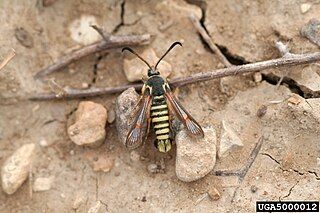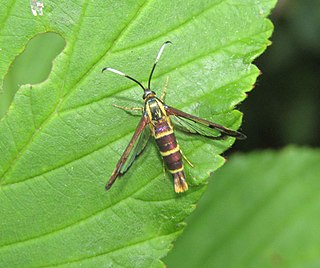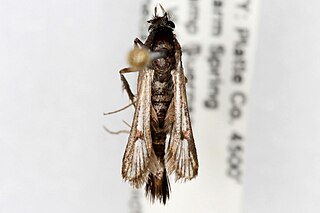
In ancient Roman religion and myth, Carmenta was a goddess of childbirth and prophecy, associated with technological innovation as well as the protection of mothers and children and a patron of midwives. She was also said to have invented the Latin alphabet.

The Sesiidae or clearwing moths are a diurnal moth family in the order Lepidoptera known for their Batesian mimicry in both appearance and behaviour of various Hymenoptera.
Carmenta is a genus of moths in the family Sesiidae.

Catocala miranda, the Miranda underwing, is a moth of the family Erebidae. The species was first described by Henry Edwards in 1881. It is found in the US from Illinois, Pennsylvania and Massachusetts to Florida and west to western North Carolina.

Carmenta mimuli, the coronopus borer, is a moth of the family Sesiidae. The dark form is the typical form and is found in Arizona. The whitish form is non-typical and is known from the south-western United States, from Kansas to Arizona.
Carmenta anthracipennis, the liatris borer moth, is a moth of the family Sesiidae. It was described by Jean Baptiste Boisduval in 1875, and is known from the United States, including Florida, Texas, Massachusetts and Illinois.
Carmenta armasata is a moth of the family Sesiidae. It was described by Herbert Druce in 1892. It is known from the US state of Texas.

Carmenta bassiformis, the eupatorium borer moth, is a moth of the family Sesiidae. It was described by Francis Walker in 1856, and is found in the United States from Massachusetts to Florida, west to Wisconsin, Kansas and Texas.
Carmenta corni, the aster borer moth, is a moth of the family Sesiidae. It was described by Henry Edwards in 1881. It is known from North America, including Wisconsin.
Carmenta odda is a moth of the family Sesiidae. It was described by W. Donald Duckworth and Thomas Drake Eichlin in 1977. It is found in the United States from South Carolina to Florida.
Carmenta pallene is a moth of the family Sesiidae. It was described by Herbert Druce in 1889. It was described from Tabasco in Mexico, but it is also known from Arizona in the United States.
Carmenta prosopis is a moth of the family Sesiidae. It was described by Henry Edwards in 1882, and is known from northern Mexico, and south-western United States.
Carmenta querci is a moth of the family Sesiidae. It was described by Henry Edwards in 1882, and is known from the United States, including Colorado and Arizona.
Carmenta subaerea is a moth of the family Sesiidae. It was described by Henry Edwards in 1883 and is known from the US state of Arizona.
Carmenta tecta, the mistletoe stem borer, is a moth of the family Sesiidae. It was described by Henry Edwards in 1882. It is known from the United States, including Arizona.
Carmenta texana, the Texana clearwing moth, is a moth of the family Sesiidae. It was described by Henry Edwards in 1881 and is known from the US states of Texas and Florida.

Carmenta verecunda is a moth of the family Sesiidae. It was described by Henry Edwards in 1881, and is known from the United States, including Colorado, Utah, California and Arizona.
Carmenta theobromae, the cocoa fruit borer, is a moth of the family Sesiidae. It was described by August Busck in 1910, and is known from Colombia and Venezuela.
Carmenta laurelae is a moth of the family Sesiidae. It was described by Larry N. Brown, Thomas D. Eichlin and J. Wendell Snow in 1985, and is known from the US state of Florida.





